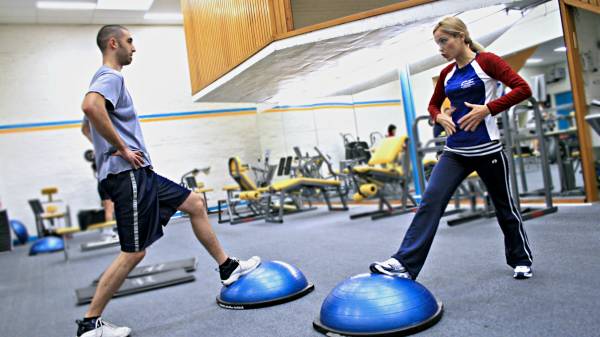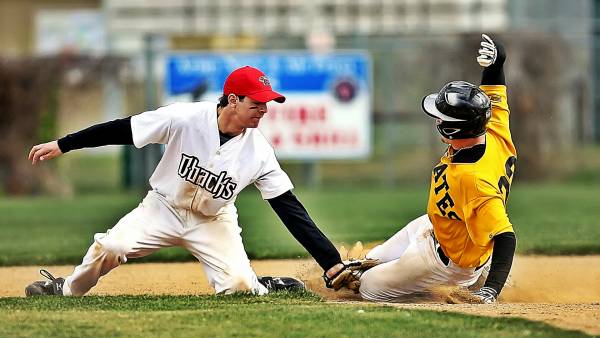Almost every one of the world’s leading car manufacturers—from Ferrari and Ford to McLaren and Mazda—has a racing division; a team of designers and engineers dedicated to building cars most of us will never drive. While these racing divisions increase brand awareness and perceived value, they do something else as well: they inform future generations of car design. In fact, all sorts of things, from seat belts and mirrors to paddle shifters and turbochargers, made their way into your car via the racetrack.
The last place these companies would look when trying to build better production cars would be to the junk yard or the repair shop, yet that’s precisely what our industry has done with functional training. Rather than looking to sports performance for insight and inspiration, we’ve turned to therapy and rehab to learn how to work with people who may not be physically fit, but who haven’t been sent in for repairs either.
Functional training is broken, because it looks to a field filled with “broken” bodies for its inspiration.
In many ways, the problem with functional training lies in how we’ve approached and understood functionality itself. As an industry, we’ve either created perplexing parodies of daily movement—each limb attached to a different band or cable and all heading in separate directions—or else borrowed many of our functional methodologies from a world filled with dysfunction. We’ve borrowed heavily from the world of the therapist, perhaps believing (wrongly) that if a movement can restore function, it can also create, protect, and improve the same. Compounding the issue is the fact that NASM, one of the most popular certifying bodies in the industry, was founded by a physical therapist, Michael A. Clark. In fairness, he’s not hiding anything; he named his organization the National Institute of Sports Medicine. But how exactly have we confused medicine with health?
Both approaches—the overly complex and the wannabe therapy—are faulty, and neglect or distort some of the more fundamental principles of program design. Rather than imitating complex movement patterns or looking to a dysfunctional population for our functional methods, my belief is that we should look to performance-driven populations and applications. In short, we should look to the world of sport. This may seem counterintuitive; Grandma Ethel doesn’t need a 42” vertical or a 4.4 40, she needs to be able to sit and stand comfortably, and get to and from the mailbox safely. We’ll address this apparent gap later on, but for now, consider the analogous example of the automotive industry, in which performance informs the practical.
Before we get into the specifics of the argument, it’s worth defining what functional training is—and should be—as well as examining a few of the ways our approach has broken down.
Adding a resistance band does not make a movement more “functional.” [Photo credit: stroopsmma | CC BY 2.0]
What the F@$k is Functional, Anyway?
A dictionary definition of functional might not look like much of the training of the same name. In its simplest form, functional simply means something that is, above all, practical or useful—something that works. It stands to reason, then, that function is dependent upon use and user, and therefore we should expect some degree of difference from one person to the next. While we all share common fundamental movement patterns, we all engage in different daily activities and have varying needs and functions. We’ll revisit this idea later, but for now let’s look at the three biggest breaks in the current approach to functional training.
Problem 1: Scope of Practice
I work as a strength coach and personal trainer. My job is to increase various fitness capacities and qualities, and make you better at doing things and staying healthy. That’s it. If you’re in pain, it’s not my job. Legally it’s beyond what I can and should be focusing on. Sure, I can try to promote better movement patterns in the hope that they prevent present and future pain, but trying to diagnose and treat existing pain, or playing around with other aspects of medicine? Not. My. Job.
Problem 2: Specificity Gone Bad
Programming 101 is rooted in specificity. Appropriate use of this principle informs intelligent athletic programming and ensures something called “rate of transfer,” which is in itself a measure of effectiveness and, arguably, functionality. Sadly, functional training has confused specificity with imitation, resulting in loaded movement patterns so specific as to be comical: I’ve seen people loading their putting stroke. Seriously, talk about “majoring in the minors.”
Instead, specificity should look to broader concepts such as plane of motion, base of support, rate of force development, load and load position etc., and challenge the body with a robust combination of the above. Let’s look at an example: thoracic rotation is a key component of a gait pattern, a single-arm throwing motion, a variety of reaching, lifting and chopping patterns, as well as scores of other movements in life and sport. A “functional trainer” might attempt to recreate each of these, banding and cabling their little heart out, while a much more practical and effective approach would be to ensure effective thoracic mobility in a variety of positions and settings over the course of a macrocycle—standing and seated, kneeling and quadruped, loaded and unloaded. Better, safer results with less time invested, leaving more time for improving fitness.
Problem 3: Function From Dysfunction
The persistent assumption that therapeutic methods imply functional methods is built on the same faulty logic that materials intended for repair are appropriate for construction. Nobody needs a bridge built out of duct tape. Dysfunction requires repair, while function requires challenge, integration, and development. If the goals are different, the methods should be as well, and yet we’re still burdened with the idea that a BOSU ball automatically makes a squat functional by recruiting proprioceptive and stabilizing resources. Unless an injury or resultant compensation is present, a human being probably has no business squatting on a BOSU ball unless their daily life involves working in a bouncy castle. It’s not functional, it’s ridiculous. Give them an asymmetrical stance, an uneven load, a shifting load, but don’t pretend that rehab is anything but that.

Why are we using tools meant for repair on people who aren’t broken? [Photo credit: LocalFitness.com.au]
Functional Requires Specificity
Earlier we defined functional as practical and useful, and acknowledged that certain fundamental patterns would be shared, but that daily life, activities, hobbies and histories would influence what might be deemed useful for an individual. For something to be useful, it must be used; specificity in its simplest form.
As a starting point, we can acknowledge that squatting (sitting and standing), hinging (bending over), pushing and pulling (moving and lifting objects), and ambulation (walking, running and crawling) patterns are nearly universal. If we temporarily set aside any differences, we can begin to look at how the general population might benefit from a performance-influenced mindset. Where an athlete may need to squat with the same depth, load, speed and frequency as their given sport, the rest of us need to squat with a depth, load, speed and frequency similar to what we experience in our daily lives. If we’re expected to carry groceries or luggage it might be a good idea to get better at carrying things. If we have a toddler it might be a good idea to get comfortable on the floor, and to get better at both getting there and getting back up.
Functional patterns may be complex, but they may also be simple. Just as athletic performance allows training to be dictated by need and results, functional training should be dependent upon the actual needs of the individual rather than an arbitrary set of ideas governing methods and modalities.
Performance and Rate of Transfer
Training for sports performance offers us an unparalleled opportunity to measure and evaluate not just an athlete’s performance, but through that performance, the effectiveness of their preparation. In other words, athletes do well with good programming and poorly with bad programming. If an athlete needs to jump higher and we prescribe a 12-week training program that results in improvement, we can assume some level of effectiveness. The better they do, the better the program. In scientific studies working with substantial populations this is referred to as the “rate of transfer,” and is commonly represented as a number between 1 and -1. An exercise scoring a 1 has the highest possible level of transfer, one scoring a 0 has no impact at all, and one scoring negatively has a negative impact on performance and therefore a negative rate of transfer.
In order to ensure the highest possible rate of transfer as well as the best on-field performance, Cal Dietz, head Strength Coach at the University of Minnesota, argues that well-designed athletic programming follows a clear pattern of progression. It will develop specific and appropriate strength qualities across a wide variety of movement patterns, and whittle away movements until only the most sport-specific remain.
The program will ensure transfer to the field of play by replicating:
- Amplitude and direction of movement (ROM)
- Accentuated region of force production: Where does an athlete need to be strongest? Generally found within 10 degrees of starting position.
- Dynamics of the effort: Training should always meet or exceed the speed and force requirements of the target movement.
- Rate and time of maximum force production (RFD)
- Regime of muscular work: Reps or training time.
Is there any difference between the approach outlined above and well thought-out programming in general? Every one of us has daily movement patterns and activities that can be subjected to the same analysis listed above. How much range of motion do we need strength in for our various activities? Do we need to be able to produce force quickly in any patterns? Which patterns need to be sustained (endurance) and which need to express maximal strength?

Athletic training has a far higher rate of transfer for the general population than therapy protocols.
Periodization for the People!
The classic block periodization model generally involves three distinct training mesocycles or blocks, each with their own particular objective:
- The accumulation block is devoted to the acquisition of a broad base of motor skills and fitness qualities for an athlete.
- The transmutation block shifts training methods to more sport-specific choices.
- The realization block typically involves a reduction in training volume to allow for the full expression of the newly acquired or improved abilities.
Applied to the general population who just hopes to look, feel, and move better, this same approach is still very much applicable. The accumulation block for everyday people would involve creating a variety of fitness qualities—strength, endurance, and power to name a few—across a wide range of movements and situations. This is as simple as learning new movements, using a variety of modalities, and appropriately progressing difficulty via load, complexity, stability, and volume.
Having done that, during the transmutation block we would pare down the movement library until we’re left with the movements that apply most directly to daily life and specific needs, from work to hobbies to injury or illness risks, and focus a little more on those.
Finally, realization for the general population may not require tapering, but would include some training to target these movements with varied elements of functional specificity: squatting with the feet on an uneven surface (replicating one foot on a curb or a step), deadlifting a moderate load in the transverse plane (hoisting groceries out of the trunk at a funny angle), or having good old Grandma Ethel create tension from the bottom of a squat up by starting her seated on a box while holding a moderate load (getting up from the couch while holding her cat).
Does My Grandma Need to Power Clean?
By now, it should be clear that the point of championing the world of sports performance as an inspiration for a more thoughtful version of functional training is not to blindly adopt its specific methods, but rather to embrace the fundamentals of the system.
In the context of athletic performance, rate of transfer measures how well an exercise regimen improves the target activity. In the context of functionality, the same standard would measure the impact on daily life. Do BOSU squats reduce falls in the elderly? Do single leg RDLS? Any coach worth his salt will value system over method, and in this case, the system is one that expects transfer. The methods? I’m not married to any, and while I have my doubts about a few, I’m willing to put those aside in favor of objective evidence of their effectiveness.
Does This Mean Everything is Simple and Sagittal?
No. Complexity is important, but complexity in the service of true need, rather than as a marketing gimmick or a way to improve a movement’s social media worthiness. Specificity has its limitations, and when training fitness rather than skill, we should be cautious when replicating complex movement patterns so as not to interfere with the complex neuromuscular interplay involved. Skill and fitness are at the far ends of an athlete’s repertoire and shouldn’t be confused with each other.
A baseball pitcher may benefit from throwing a weighted ball on occasion, but I’ll leave that portion of his training to someone with a more expert eye for the mechanics of his throwing motion, and limit myself to things like improving his ability to generate force in the transverse plane, drive off of his leg and stride forward, and effectively generate and link force through his entire kinetic chain. In the same spirit, I’m not prepared to load each and every specific motor pattern an individual may encounter, and will instead limit myself to training broad categories of movement and developing strength, endurance, speed, or power within those more general movements.
Your Take-Home Cheat Sheet
I have effectively buried you under an avalanche of words. Let’s simplify my arguments by giving you some talking points to summarize how we can all train like athletes:
- Skill and fitness are not the same thing and cannot be trained the same way.
- Fitness qualities should be developed across a diverse and robust set of movements.
- Complexity does not equate to functionality.
- Neither does simplicity.
- Rate of transfer can be applied to sport and life alike.
- Methods are neither functional or not; instead, they depend on an objective measure of transfer to the target movement.

More about the F-word:






